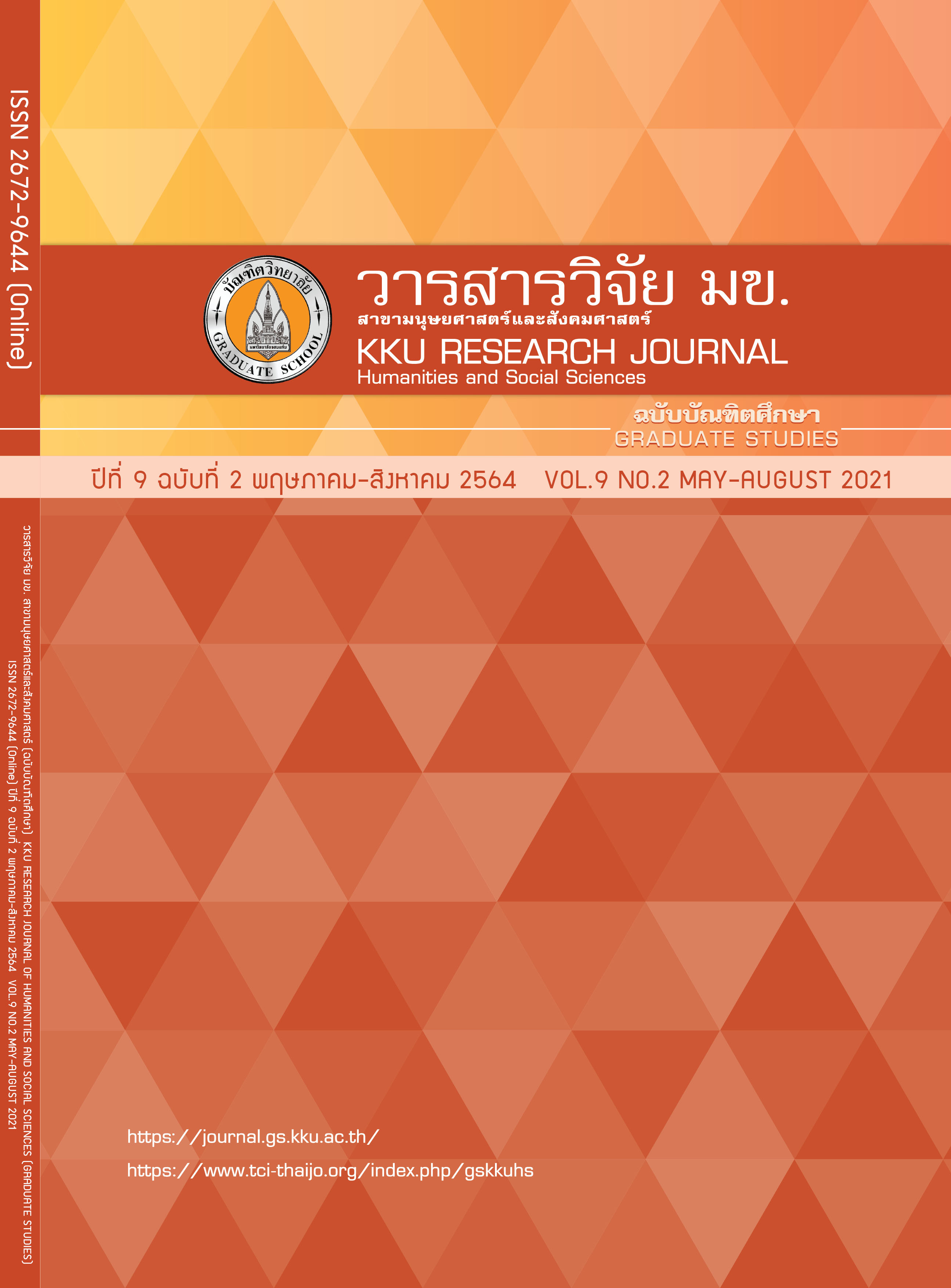Implementing English-medium Instruction (EMI) in Thailand: University Students’ Perspectives
Keywords:
English academic skills, English proficiency, Medium of instructionAbstract
This study aims to explore the perceptions of higher education students concerning English as a medium of instruction for teaching international programs at one of the public universities in Thailand. A total of 128 students were selected from six programs participated in the current study using a stratified random technique. They completed a self-assessment questionnaire about their experiences on their English academic skills as the impacts of EMI courses. A survey method was employed using descriptive and inferential statistics to analyze the quantitative data generated. The descriptive results indicated that students possessed the highest proficiency in reading skills (mean score = 3.30). This is followed by writing skills (mean score = 2.77) and interactional skills (mean score = 2.72). Moreover, one-way ANOVA showed a significant difference in reading and writing skills. Finally, the three English academic skills showed significant inter-correlations.
References
Macaro E, Curle S, Pun J, An J, Dearden J. A systematic review of English medium instruction in higher education. Language Teaching. 2018; 51(1): 36-76.
Wächter B, Maiworm F. English-taught programs in European higher education: The state of play in 2014. In ACA papers on international cooperation in education. 2014.
Galloway N, Ruegg R. The provision of student support on English medium instruction programs in Japan and China. Journal of English for Academic Purposes. 2020; 45: 1-14.
Hengsadeekul C, Hengsadeekul T, Koul R, Kaewkuekool S. English as a medium of instruction in Thai universities: A review of literature. Selected Topics in Education and Educational Technology. [Internet]. [Cited 2020, May 8]. Available from: file:///G:/English%20as%20Medium%20of%20Instruction/ 14eaec60d451073cb724e9d62f52ab897f75.pdf
Commission on Higher Education. Study in Thailand 2008-2009. Bangkok: Bureau of International Cooperation Strategy; 2008.
Galloway N. How effective is English as a medium of instruction (EMI)? [Internet]. [Cited 2020, May 7]. Available from: https://www.britishcouncil.org/voices-magazine/how-effective-english-medium-instruction-emi
Suntornsawet J. Problematic phonological features of foreign accented English pronunciation as threats to international intelligibility: Thai EIL pronunciation core. The Journal of English as an International Language. 2019; 14(2): 72-93.
Jufri Y, Mantasiah R. The interference of first foreign language (German) in the acquisition of second language (English) by Indonesian learner. The Asian EFL Journal. 2019; 23(6.3): 27-41.
Cai J. College English Education: A return from GE to EAP. Foreign Languages and Their Teaching. 2014; 274(1): 9-14.
Jiang L, Zhang LJ, May, S. Implementing English-medium instruction (EMI) in China: Teachers’ practices and perceptions, and students’ learning motivation and needs. International Journal of Bilingual Education and Bilingualism. 2016; 1-13. DOI: 10.1080/13670050.2016.123166
Bunwirat N. English language teaching in AEC era: A case study of universities in the upper northern region of Thailand. Far Eastern University Journal. 2017; 11(2): 282-293.
Bunwirat N, Chuaphalakit K. A case study of English teachers’ perception toward the significance of English in ASEAN. In Proceedings of the 38th National Graduate Research Conference: Graduate research toward globalization. 2016; 3(1): 29-37. Phitsanulok, Thailand: The Graduate School, Naresuan University.
Barbin RRF, Nicholls PH. Embracing an ASEAN Economic Community: Are Thai students ready for the transition? AU-GSB e-Journal. 2013; 6(2): 3-10.
Choomthong D. Preparing Thai students’ English for the ASEAN Economic Community: Some pedagogical implications and trends. Language Education and Acquisition Research Network (LEARN) Journal. 2014; 7(1): 45-57.
Deerajviset P. The ASEAN Community 2015 and English language teaching in Thailand. Journal of Humanities and Social Sciences. 2014; 10(2): 39-75.
Phantharakphong P, Sudathip P, Tang KN. The relationship between reading skills and English proficiency of higher education students: Using online practice program. Asian EFL Journal. 2019; 23(3): 80-103.
Pyakurel S. ASEAN Economic Community and its effects on university education: A case study of skill verification by the means of professional certification examination. Unpublished master’s thesis. 2014; Bangkok University, Thailand.
Bancha W. Problems in teaching and learning English at the Faculty of International Studies, Prince of Songkla University, Phuket. Unpublished Ph.D dissertation. 2010; Prince of Songkla University, Thailand.
Chapple J. Teaching in English is not necessarily the teaching of English. International Education Studies. 2015; 8(3): 1-13.
Shuib M. English as a medium of instruction in higher education. [Internet]. [Cited 2020, August 21]. Available from https://medium.com/@munirshuib08/english-as-a-medium-of-instruction-in-higher-education-f701940b07b6
Grabe W. Current development in second language reading research. TESOL Quarterly. 1991; 25(3): 375-406.
Grabe W, Kaplan RB. The writing course. In Bardovi-Harlig and Hartford, B. Beyond methods: Components of second teacher education. 1997; 172-197.
Kim H, Krashen S. Why don’t language acquirers take advantage of the power of reading? TESOL Quarterly. 1997; 6(3): 26-29.
Lipson MY, Wixson KK. An interactive view of reading and writing. Addison-Wesley: Educational Publishers. 1997.
Oxford RL, Scarcella RC. Second language vocabulary learning among adults: State of the Art in Vocabulary Instruction. 1994; 22(2): 231-243.
Madileng MM. English as a medium of instruction: The relationship between motivation and English second language proficiency. Unpublished Master ‘s thesis. 2007; University of South Africa, South Africa.
Lei J, Hu GW. Is English-medium instruction effective in improving Chinese undergraduate students’ English competence? International Review of Applied Linguistics in Language Teaching. June 2014; 52(2): 99-126. DOI: 10.1515Iral.2014.0005
Wanphet P, & Tantawy, N. Effectiveness of English as a medium of instruction in the UAE: Perspectives and outcomes from the instructors and students of University Science Courses. Educational Research for Policy and Practice. 2018; 17(2): 145-172.
Galloway N, Kriukow J, Numajiri T. Internationalization higher education and the growing demand for English: An investigation into the English medium of instruction (EMI) movement in China and Japan. The British Council; 2017.
Wang ZY. Investigating ESP teaching for English majors in Technological Institutions. Contemporary Foreign Languages Studies. 2015; 11: 50-53.
Babbie E. The basic of social research. 6th ed. Belmont, CA: Wadsworth Cengage Learning; 2014.
De Vaus D. Survey in social research (6th ed.). England, UK: Routledge Taylor & Francis Group; 2013.
Evans S, Morrison B. Meeting the challenges of English-medium higher education: The first-year experience in Hong Kong. English for Specific Purposes. 2011; 30(3): 198-208.
Macaro E, Curle S, Pun J, An J, Derden J. A systematic review of English medium instruction in higher education. Language Teaching. 2018; 51(1): 36-76.




